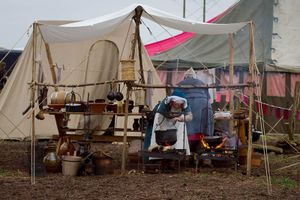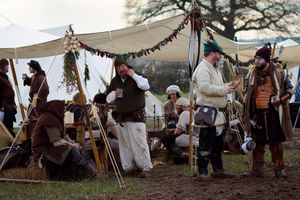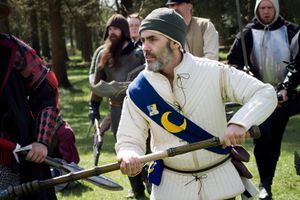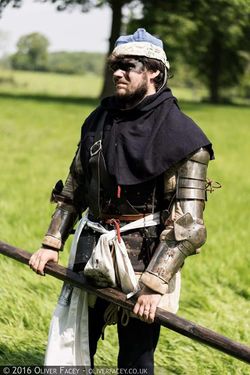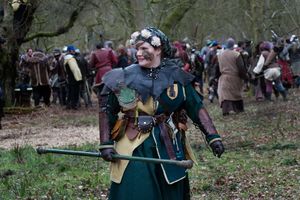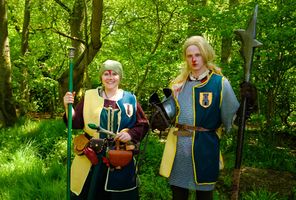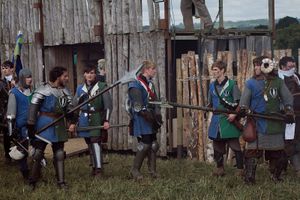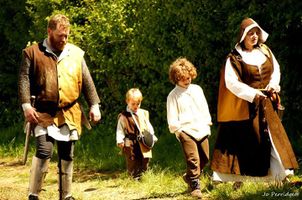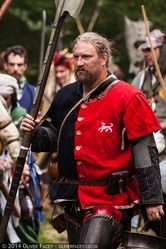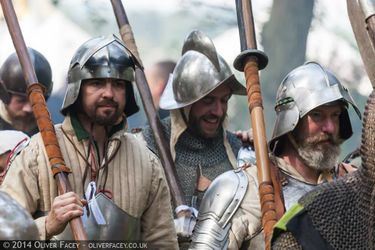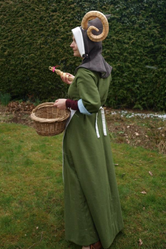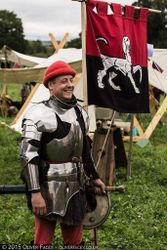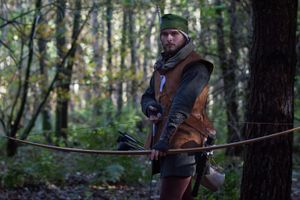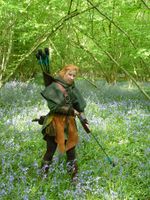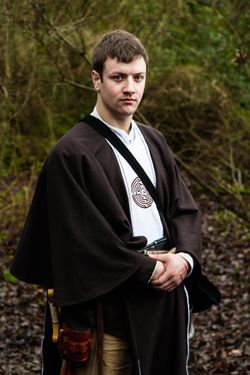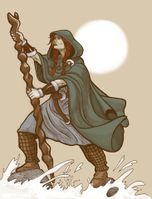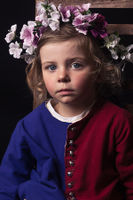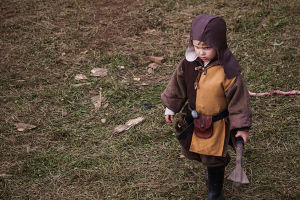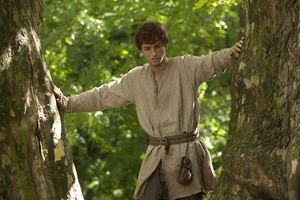The Marches look and feel
Overview
The Marches draws strongly on English history from the 12th century through to the War of the Roses for costume, weaponry and armour.
The costume of the Marches has a 'solidity' to it, a worn, lived-in look that contrasts with its neighbour Dawn's high romance, gleaming plate and vivid hues. The Marches is Kenneth Brannagh’s Henry V rather than Laurence Olivier’s.
Breakdown
Feel
Gritty, solid, practical, traditional, mud, blood, green fields, rural, iron.
Influences
Wars of the Roses England, Rangers of Ithilien (Beaters), Cadfael (Monks and Landskeepers).
Materials
Wool, calico, linen, leather.
Colours
Plain flat colours, mostly the soft colours of natural dyes or unbleached cloth. The palette is autumnal suggesting natural dull blues, greys, browns/ rusts, mustards and greens, dull reds etc. especially at the lower end of the social scale. Wealthier Marchers may use deeper, brighter shades.
Icons
- Livery Members of a household generally wear their livery in some way – as a livery coat, sash or pewter badge.
- Poppets and other symbols of the land play an important role in the Marches hearth magic. Many Marchers, all children and every home in the Marches have at least one poppet.
- Apples The symbol the apple, and fruit and seed in general, is a common representation of the soul and the cycle of rebirth.
- Crow and Rat are both images of ill-omen and bad luck.
Clothing
Marchers favour plain clothes, tunics, simple hoods, hose and shirts. Wealthier characters might wear finer robes, cotehardies or a simple doublet, but even then plain wool or heavy linen will be more appropriate than fancy patterns or embroidery. Medieval re-enactments are a great source of inspiration for the look and feel of the Marches territories - although unlike history, its worth noting that Marches society is gender neutral.
Marcher leg wear is practical and slim fitting. Close fitting trousers are practical and easy to come by or make. Hose, either joined or split, are worn with braies and a long shirt. An extremely simple untailored cut for shirts fits the Marches very well: Full in the body and sleeve, possibly gathered at neck and wrist.
Doublets are popular in the Marches, a snug-fitting buttoned jacket that is shaped and fitted to the body. It can be worn over the shirt or under another layer of clothing. They tend to be short and simple – fancy slash work doesn't really fit the Marchers practical approach.
A woollen or heavy linen overdress such as a kirtle or cotehardie over a shirt or shift is be a good alternative to shirts and hose. The look is long, lean and smooth and laced to fit. Back lacing shows higher status and gives a better line. Side lacing is more common. It would be rare to see a gathered skirt (common to Tudor kirtles) in the Marches.
Headwear is frequently worn, from a simple cap or coif, to hats or something like a hood with liripipe or a chaperon.
Marchers have no pockets, so a pouch is invaluable – bollock or kidney pouches or leather bags are perfect. Belts are often very long, wrapped round, looped at the front and left to dangle.
The typical clothing of both male and femals monks and friars consists of a traditional plain monk's habit.
Camps
Gates and doors are traditionally decorated with woven bundles of grain on either side, the respect shown to the land prevents evil doers from entering. The hearth is where food taken from the land is prepared. It should always be kept clean and ideally be decorated with fresh cut flowers to prevent food cooked there causing a poison of the blood. Poor March Folk or those on campaign will make do with bundles of grass or common meadow flowers.
Weaponry
The classic Marcher fighting unit is a block of bills and other polearms recruited from the yeomanry. Two handed swords are common for richer characters in heavier armour, as well as warhammers, maces or poleaxes. Any historical weapons from the Hundred Years War and the War of the Roses are typical: poleaxes, bills and other polearms are iconic; warhammers, bollock daggers, axes, falchions, mauls, and improvised weapons based on farm equipment are all carried by some. .
Bows, in particular longbows, are also a common sight among the Marchers units on the battlefield.
Armour
Padded gambesons or leather jacks are common for the poor, with a harness of plate for richer individuals. Brigandine is an intermediate option. Households often wear matching livery coats, although simple sashes or badges are also used to denote affiliation. Jack chains over a gambeson are ideal for a Marcher yeoman.
Mage armour is often from similar materials - fabric, leather and possibly pieces of chain mail - in both natural and household colours, but is more likely to be adorned and decorated with elements of no immediately obvious use.
Shields
Large shields are much less common than in other nations; shield-walls are seen as a tactic best left behind in Dawn. Marchers who have a good reason not to use a polearm or a great sword, such as martial Landskeepers fearing arrows, or skirmish groups protecting the flanks will often use a small buckler to go alongside their weapon of choice.
Marcher household
Any Marcher who owns farmland is a member of a household, albeit perhaps a household of one, and any Marcher Household can declare a livery. Members of the household tend to wear the livery colours in some way. Stewards of a household that allies to a more powerful household usually retain their own livery, or combine it with the new households’ colours in some way. Households often wear matching livery coat|livery jackets, although simple sashes or badges are also effective ways of showing affiliation. Many households own a banner showing their livery.
Yeomen
Poor Yeomen may wear just a plain coloured jack or padded gambeson as their only armour. Wealthier Yeomen usually have livery coats in their Household colours and mail or plate over the top if they have it.
Stewards
The head of a household, a steward, may wear richer colours, but most likely in home grown wool not rarer silk. Wealthy Marchers are often seen in full harness of plate in battle.
Beaters
Beaters are skilled trackers and gamekeepers. They watch the borders of the Marches. They are inspired by the classic British archers of the period mixed with the Rangers of Ithilien from Lord of the Rings. Beaters usually wear lighter armour, either just a padded or leather jack or else a leather tunic like the ones worn by the Rangers in Lord of the Rings.
Aldermen and Townsfolk
Many aldermen take great pride in their ceremonial chains of office, sometimes referred to as "Chains of Prosperity". Some go so far as to commission them as magical items, such as an Alderman's Edge.
Monks and Friars
Both male and female monks and friars wear traditional plain monk's habit either in dark colours, or white with a dark scapular.. A simple brown cassock works well but it might also be seen in black or grey. A more complex arrangement with dark scapular over white undergarments is also a popular choice. A chasuble or cowl may be worn over the habit, in particular during the cold seasons, but monks and friars alike tend toward simple outfits.
Landskeepers
Some landskeepers wear robes, similar to the monk, but a jerkin, shirt and hose, with rolled-up sleeves is just as good an alternative. A landskeeper is well used to hard work in the fields and their look reflects that.
Children's costumes
Children in the Marches can be dressed in scaled down versions of their parent's clothes. For toddlers and babies, traditional smocks, or simple t-tunics and drawstring trousers are simple and easy to pull-on garments, that can be made in linen or cotton for easy washing! These types of clothes also have plenty of flexibility in terms of size, meaning you'll get more than one year's use out of them. Small coifs are great for keeping the sun off a baby's head and simple straw hats can also be used to stop children burning. Older children can either have their own costumes, or be given adult clothes which are then rolled up and belted to fit - the practical Marchers are unlikely to waste any clothing and hand me downs are a cheap (in and out of character!) way to clothe children.
General tips for costume for children:
- Robes that stop at knee - mid-calf will be less of a trip hazard
- Headgear that can be very simply retied is great
- Avoiding things that can pull around the neck is wise (strings on cloaks/hats on cords/ tabards that don't secure under the arms
- Wider neck holes, sleeves and armholes will help with getting costume on and off, and leave room for growth
- Information on clothes and swaddling for babies
- Patterns for Medieval children's clothes
- Childrens' dresses
- Childrens' shirt, tunic and hood
- 'Mother and Daughter' dresses
- Revival Clothing's Premade items for children
- Gambeson's Premade items for children
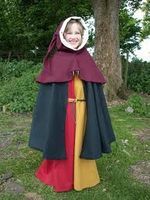
10 Quick Costuming Tips
We strive to treat the mud with care
with lots of muck and tilling.
And it repays us thousandfold:
That’s why its so fulfilling.
And when the day is over,
we’ll drink a glass or more,
to Marcher mud - its in our blood, ingrained in every pore.
We’re down to earth,
down and dirty:
- Charity shop fabric rails are a great source of wool blankets that can be made into staples of Marcher costume.
- With the popularity of medieval re-enactment, its very easy to buy off the peg hose, doublets, cotehardie and other key pieces. 12th–15th century kit is preferable to Tudor kit when choosing on-line or at kit fairs.
- Instead of actual hose, any reasonably close fitting trousers in earthy or dark colours will look good for practical Marches characters.
- Households and families are important in the Marches - displaying the house livery can be done cheaply through simple sashes or badges or if you fancy something a bit clearer, follow the guides for livery coats.
- There are a range of options for practical footwear - from bespoke re-enactment shoes to simple desert boots. Any soft leather or suede with simple ties, laces or side buckles will look good.
- There is no need to worried about all that itchy wool and linen: Shirts and shifts are both are simple, loose and easily available in cotton and make a good part of the Marchers look. And whilst re-enactment markets are very useful for Marcher supplies, we're not looking for historical accuracy here – There's no expectation for you to be in itchy underwear!
- For those playing a rich Marcher, it could be easy to make choices that make the costume seem very similar to neighbouring Dawn. By sticking to plain fabrics (wool, maybe velvet, but not silks or brocades) and choosing rich autumnal colours rather than bright summery ones confusion can be avoided.
- Marcher beaters who are likely to wear light leather armour can avoid being confused with Steinr and Navarr by staying away from furs and going for classic Marcher accessories. Bollock pouches are one example that are really simple to make and easily available to buy.
- Want to indicate low status? Try adding an apron or leather trousers or swap a doublet for a sleeveless jerkin.
- Want to show off high status? Try doing so very discreetly, with a rich lining or carefully chosen buttons rather than ostentatious trims and decoration.
Things you're unlikely to see
- Don't expect 'bling' in the Marches, even the wealthy are likely to be subtle - with wealth displayed in linings and button detail, not slashed sleeves, full gathered fabrics, or rich embroidery or brocade.
- You won't find anyone worrying about hand stitching, whether that coat is too long for 1389 or what your underwear is made of. The Marches is a historically inspired culture, not a historically accurate one.
- There are no modesty guidelines in the Marches and gender roles don't follow the historical pattern - long skirts and laced dresses are a choice made by some not an expectation of all.
Costume Sources
As the Marches draw on inspiration from Earth history, there are both vendors of appropriate items of costume and documents dealing with the costume styles easily available for Marcher players looking for more details.
Historical Women's Wear Reference Material
As with military clothes, dresses can reflect household livery. 'Parti-coloured' (or split coloured) dresses look very effective. Lara Corset's website gives an excellent overview of all aspects of women's wardrobes in the late 1400s,
Matilda la Zouche's wardrobe follows the reconstruction of several historically accurate outfits for a broad medieval period.
Some general pattern books are available which cover all types of women's wear:
- Medieval Women's dress
- High medieval women's dress
- The Medieval Tailor’s Assistant
- Make Your Own Medieval Clothing for women.
- Nehelenia Patterns - Multi part pattern for men and women
Historical Men's Wear Reference Material
Some general pattern books are available which cover all types of men's wear:
- High Medieval men's dress
- Medieval men's dress
- The Medieval Tailor’s Assistant
- Make Your Own Medieval Clothing for Men
- Nehelenia Patterns - Multi part pattern for men and women
Reenactment Sources
Medieval re-enactment, Wars of the roses and 13th, 14th or 15th Century re-enactment will all provide helpful inspiration.
Guides to Livery
- 15th Century Livery
- Livery coats
- Standards, Badges & Livery Colours of the Wars of the Roses, Pat McGill & Jonathan Jones, Freezywater Publications
- Heraldic Banners of the Wars of the Roses (3 vols), Pat McGill & Thomas Coveney, Frezywater Publications.
- Medieval Art and Woodcraft make livery badges, banners and flags, signage, medical charts etc. to order
Books
- The Medieval Soldier: 15th Century Campaign Life Recreated in Colour Photographs, Gerry Embleton & John Howe,
- English Medieval Knight 1400-1500, Christopher Gravett, Osprey Publishing
- The Great Warbow, Matthew Strickland & Robert Hardy, Sutton Publishing – probably the best accessible book you can get on the subject.
- Arms and Armour of the Medieval Knight, David Edge & John Miles Paddock, Saturn Books
Costume sellers
- The Midgard Seamstress Custom made UK LARP and Re-enactment costumes
- Arm Street Medieval and Fantasy clothing from Russia (English language website)
- Cloak’d and Dagger’d
- Custom Costume Company Bespoke designs for re-enactors and roleplayers
- Historic EnterprisesAmerican based costume company. Trades at TORM
- Medieval Dress Company Clothing and leatherwork
- Matuls Clothing, armour tents and camp accessories from Poland (English language website)
- Revival Clothing
- Sally Green
- Sew-mill
Armourers
- https://www.facebook.com/ArmourServices
- https://www.facebook.com/pages/The-Medieval-Rats/147041485362649
- http://www.armabohemia.cz/Novestr/homeA.htm
- http://www.armorymarek.com/
- http://www.bestarmour.com/
- http://www.capapie.co.uk/
- http://www.dtok.fsnet.co.uk/
- http://www.lancasters-armourie.co.uk/
- http://www.stgeorgearmouryshop.co.uk/index2.html
- http://www.whiteroseapparel.com/
- http://www.whiterosearmoury.com/
- Darkblade studded leather armour
- Totally Leathered Totally Leathered provides custom tooled leatherwork & bespoke armour.
- Idiom Productions Costume and Props Workshop creates custom hand-tooled leather armour, clothing and LRP weapons
Leather items including shoes
- Phil Fraser
- Re-enactment shoes
- Historical Shoes
- Historic Shoes German company (English language website)
- Ravenswood Leather Items America site. Non-historical leather items.
Fur and traditional materials
- House of de Clifford Ethically sourced furs of all kinds
- Candles for All Ages Tallow and Beeswax Candles
- Herts Fabrics
- Bernie the Bolt
Camping accessories and other bits
- Sally Pointer Hats and bits and bobs
- Smoke and Fire American company.
- Medieval Market German company (English language website) – Clothing, furniture, and other items
- Medieval Dress Company Clothing and leatherwork
- Matuls Clothing, armour tents and camp accessories from Poland (English language website)
- Reenactors Shop German company (English language website) Lots of bits and bobs, including camping accessories.
- Medieval design 1st -16th century clothing, furniture and other historical products.
Flags, banners and livery badges
- Medieval Art and Woodcraft Historical and historically inspired banners, flags and livery badges
Pewter and cast goods
- Casts from the Past Pewter items including livery badges and some household items
- The Quiet Press Historical buckles, brooches and other ornamental metalwork
- Billy and Charlie's Finest Quality Pewter Goods American company. Pewter badges and other accessories.
- HR-Replikate German company. Jewellery based on archeological finds (English language website)
- Lionheart Replicas Pewterwear
- Pewter Replicas Pewter badges, household items and livery collars
Wooden items
- Douggie the Wood Wooden Furniture
- Robin Wood Authentic wood turned historical items
- Paul Atkin Bowls and other hand turned items

